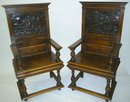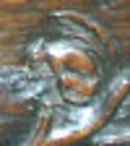Carved Armchairs




Unavailable
These extraordinary, heavily carved chairs pay tribute to the Roman goddess Ceres (also known to the ancient Greeks as Demeter), who was considered responsible for bountiful harvests as a reward to farmers for wise and careful cultivation of the soil. They evoke the Renaissance tradition of eschewing Christian subjects in art and harking back to the pagan rituals and deities of ancient Greece and Rome. While classical mythology is rich in stories about the ancient gods and goddesses and their all too human predilections, those swirling around Ceres and Demeter emphasize a kind heart and an interest in the well-being of humans underlying her concern for annual, abundant harvests. Indeed, Ceres carries on in our modern world as the origin of the word cereal for the breakfast foods made from grain.What attracted us to these chairs, besides our #1 priority of sturdy construction, was the intricacy and masterful nature of the hand carving of the back panels, coupled with the rich color of the old-growth walnut. While a matching pair in design, the two carved panels are distinct, each showing a different scene with Ceres as the focal point. The figures of Ceres, with her floral crowns, standing in classic contrapposto poses while clutching samples of the harvest, can be traced directly to sources in antique sculpture such as the life-size statue of Livia as Ceres in the Louvre. In particular, we were captivated by the anachronistic and highly detailed scenes of the medieval walled villages in the background, complete with smoke curling from chimneys, while the ancient Roman goddess, scantily clad in a time of global cooling, gathers grain from the harvest or carries a cornucopia of ripe fruit. In these tasks she is assisted by several charmingly depicted representatives of the animal kingdom. On the chair at the left in the photo, a goose and disproportionately huge snail are her companions, while on the chair at the right, a dog accompanies her while a disproportionately large squirrel observes from a tree branch. The overall structure of these armchairs has its roots in the 16th century in France when the focus shifted from large, high-backed throne-like seating to comfortable occasional chairs that were more portable and decorative. Particularly during the reign of King Henri II and his Queen (the former Catherine deMedici), who brought with her to France the top artisans from her Florentine home, enthusiasm for Roman mythology and its evocation in furniture reached its zenith. Especially on cabinets and chests, highly-carved scenes such as these were taken from books of engravings circulating among furniture makers throughout France. Indeed, we have not discounted the possibility that the panels existed previously as part of another piece of furniture and were recycled into these chairs, now antiques in their own right, in the 19th century.In keeping with 19th century and earlier styles where chairs were expected to be backed against walls when not in use, the reverse sides of these chairs are uncarved although the grain of the walnut is exquisite and too lovely to be hidden from view. These chairs reflect the standard construction designs of the 16th century, having solid, gracefully shaped turnings used as vertical supports and, instead of a perpendicular stretcher, a foundation in the form of horizontal mouldings connecting the four legs at their base. There is an old repair to the figure of Ceres on the chair at the right, which we have not tampered with in order to maintain the integrity of the piece as an antique. These chairs are truly works of art in the tradition of the finest French craftsmanship and reverence for the beauty of old-growth walnut. Boccador, Jacqueline, Le Mobilier Français du Moyen Age à la Renaissance, Editions dArt Monelle Hayot (Saint-Just-en-Chaussée, 1988); Burckhardt, Monica, Mobilier Moyen-Age, Renaissance (Editions Ch. Massin, Paris, Undated); Thirion, Jacques, Le Mobilier du Moyen Age et de la Renaissance en France (Editions Faton, Dijon, 1998). While these chairs would be appreciated in most any setting, to draw attention to the beauty of the carving we suggest that they be used in an entryway or alcove with recessed lighting focused on the carved panels. Sturdy and eminently sittable, these chairs could benefit from seat cushions in keeping with the overall theme of Roman mythology. For more information, visit M. Markley Antiques on the Web -- the premier resource in the U.S. for French Gothic Revival and Renaissance Revival furniture, including Henri II and Louis XIII styles.
M. Markley Antiques
Spring, Texas
Dealer accepts: Check
Shipping: Negotiated with Seller



